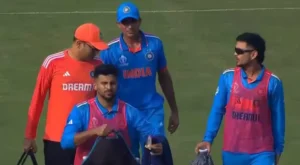In the World Cup semifinal match against New Zealand, India’s opener Shubman Gill was forced to retire hurt on Wednesday at the age of 79 due to cramps in his left leg. After 23 overs, the hosts had reached 165 for one.
With his stunning array of strokes during the match, Shubman Gill, 24, was quickly moving up the list of Indian batters with the highest totals; however, in the 23rd over, he was forced to leave the pitch due to severe cramps. Depending on how quickly he recovers, right-handed Shubman Gill may be able to bat later in the innings.
When the ball is dead, a batter may end his or her innings at any moment. The umpires must be notified of a batter’s retirement before permitting play to resume.
A batter is entitled to finish his or her inning if they retire due to illness, injury, or any other unforeseen circumstance. The batter will be listed as “Retired – not out” if, for whatever reason, this does not occur.
A batter’s innings may only be continued with the opposing captain’s permission if they retires for any reason other than those listed in 25.4.2. Should their innings be stopped for any reason, the batter will be marked as “Retired – out.”

If a batter retires and then returns to the field, they can only do so in response to the fall of a wicket or the retirement of another batter, subject to the rules in 25.4.2 and 25.4.3.
In the World Cup final four matches, he already has the fourth-highest score of any Indian.
Shubman Gill played an incredible knock of 65 balls with eight fours and three sixes before he hobbled off the pitch. He shared two crucial stands with his senior partners, Rohit Sharma (47), and Virat Kohli (35), who was batting.
After Rohit, who was hitting a 29-ball 47 with four sixes and as many boundaries, was playing the role of the ideal second fiddle, Gill gradually improved to make a strong contribution.
Gill and Kohli put on another 101-run second-wicket stand before Gill retired hurt after India lost Rohit late in the powerplay.
After Suryakumar Yadav is dismissed, Shubman Gill rejoins KL Rahul in the middle of the wicket.
Shubman Gill, who was hitting 79 off 65 balls, hobbled off the pitch during the World Cup semifinal match against New Zealand after collapsing due to cramps.

Following their impressive display during the World Cup, Team India has continued to play at a fast pace in their semifinal match against New Zealand at Mumbai’s Wankhede Stadium. India got off to another explosive start when Rohit Sharma and Shubman Gill won the toss and chose to bat first. Before Rohit was dismissed for 47(29) against Tim Southee, the two scored 71 in 8.2 overs.
After Virat Kohli entered the game, he and Gill kept things going until Team India suffered a serious scare from injuries. After suffering cramps, Gill, who was hitting 79 off 65 balls, hobbled off the pitch and retired injured.
Can Gill go back to batting?
Sure. Gill is still alive. He recently left the pitch to receive medical attention. At the fall of any wicket, he can stroll into the bat.

Who took Gill’s place?
Shreyas Iyer, the No. 4 for India, took Gill’s place and teamed up with Virat Kohli to advance the Indian innings.
What would happen in the semi-final if Gill is unable to bat?
India will then start with ten batters. Cramping replacement injuries are not permitted. A team can only substitute a player for another player during a game if that player has suffered a concussion.
Shubman Gill retired hurt during the India-New Zealand World Cup semi-final on Wednesday in Mumbai, partly due to the dengue that kept him out of the tournament from the beginning.
When Gill left the pitch in the 23rd over of India’s innings, he was batting on 79. He came back to bat in the final over, following the removal of the fourth wicket, and fielded during New Zealand’s innings. Since then, he has affirmed that he is healthy to play in the November 19 World Cup final in Ahmedabad.





